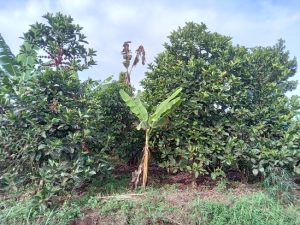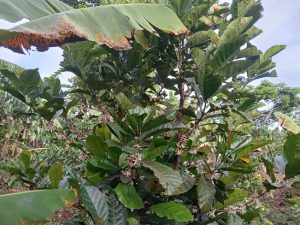A Kisansa coffee tree with ripe cherries at Ntabazi’s farm in Kassanda district/Business Focus photo
At first sight, you may mistake it for a jackfruit tree. It’s a giant tree, almost 10 meters high. It’s inter-cropped with Robusta coffee.
However, this rare tree doesn’t have jack fruits but coffee cherries. This is what I witnessed in Kigalama village, Kiganda Sub-County in Kassanda district while on duty on March 20, 2023.
According to research, this coffee variety is locally called Kisansa. Globally, it is known as Coffea liberica (Liberica). It’s also well known as Excelsa coffee variety.
This coffee variety is unique and different from Robusta and Arabica that consist 80% and 20% of Uganda’s coffee production respectively.
Kisansa isn’t yet recognized as a commercial crop/variety in Uganda, but it has great potential to make money for farmers. At the moment, Robusta and Arabica are the only coffee types commercially recognized in Uganda.
Edward Ntabazi, a Robusta coffee farmer with a few Kisansa trees in Kigalama, says he likes ‘the new variety’ because it is rarely attacked by diseases and pests.
“My Robusta coffee trees are attacked by Coffee Wilt Disease and Black Coffee Twig Borer, but Kisansa hasn’t been affected yet,” he says.
Ntabazi reveals that Kisansa starts producing/flowering at about four years and the yields increase as the tree grows bigger.
Just like Robusta, he says, Kisansa requires good agronomic practices to get higher yields.
Asked about the market for Kisansa, Ntabazi, said he normally gets buyers specifically interested in Kisansa coffee. He says it has bigger beans and therefore heavier compared to Robusta beans.
A study carried out by Uganda Coffee Development Authority (UCDA) and National Coffee Research Institute (NaCORI) in 2018 about Kisansa Coffee, revealed that this coffee has great potential to diversify the fortunes of the coffee sector in Uganda amidst climate change constraints, pest and disease challenges, decreasing soil fertility, low farmer productivity, as well as being a good source of genetic diversity for improved coffee variety selection.
According to the study report released in 2019 and exclusively obtained by Business Focus, farmers growing it cited its conducive harvest time in the times of limited alternative income sources, excellent yields (10-200kg of red cherry per tree/per year), high/absolute resistance to pests and diseases especially coffee wilt disease and coffee leaf rust as the major factors for its preference.

The study was carried out in the emerging major Coffea Liberica/ Kisansa growing districts of Butambala, Kamuli, Kyotera and Luweero in central Uganda and Arua, Moyo and Koboko in the west Nile region of Uganda.
The study was carried out by Job Chemutai Alunga, a NARO/NaCORI Scientist/Breeder; Juliet Nanyonga, a Quality Assurance Officer from the UCDA Directorate of Quality and Regulatory Services; and Edward Lutaakome-Ssentamu (UCDA Regional Manager/Central) from the UCDA Directorate of Development Services.
According to the study report, cupping of the samples was done by a panel of experts in UCDA’s Lugogo based laboratory.
“The samples had a high average score of 80% with various special profile notes. Physical bean analysis showed that 59% of the analyzed Coffea liberica (kisansa) coffee beans were screen 19, followed by screen 13; only 4% had less than scree 12. Further analysis show that the overall moisture of the analyzed FAQ coffee was 11.2. Overall, average out-turn of coffee was 95% with 87.3% as minimum out turn and 98.8% maximum out turn,” the report says.
Globally, there’s renewed interest in traditional, large-seeded Liberica. Producers in Asia (including in India, Malaysia, Indonesia and the Philippines) and Africa (for example, Sierra Leone) are responding to consumer interest (and demand) in this coffee. Renewed interest from farmers is perhaps also due to the low farm-gate prices paid for Robusta coffee, which has a commodity price at least two fold lower than Arabica.
Slow Food Uganda, an organization focusing on preventing the disappearance of local food cultures and traditions, has been promoting Kisansa variety in Luwero and the Central region since 2015.
In an exclusive interview with Business Focus, John Wanyu, the Programs Officer-Biodiversity Protection at Slow Food Uganda, revealed that Kisansa coffee is one of the traditional coffee varieties indigenous to Uganda. It is a ‘wild’ coffee tree in some of the natural forests in Uganda.
Asked on what prompted them to promote Kisansa Coffee, Wanyu said they wanted to save this unique coffee variety from extinction on top of its economic value. He says there’s a Liberica variety (Kisansa) that is indigenous to Uganda and one that is indigenous to Liberia.
“Uganda is the motherland of Kisansa (Liberica coffee). It needs to be safeguarded from extinction,” Wanyu says.
Wanyu adds that Kinsansa coffee is planted at a spacing of 20 meters by 20 meters.
“A properly grown Kisansa coffee tree (of 10 years and above) can yield 300kgs of red cherries per year,” Wanyu says, adding that Kisansa coffee doesn’t compete with other plants.
“It can be inter-cropped with Robusta coffee and bananas,” he says.
Slow Food is currently working with 41 farmers, who are producing between seven and twelve tonnes of pure Liberica/Kisansa per year.
Wanyu says the 41 farmers have since given out seedlings to other farmers who pick interest in this coffee variety.
However, this website understands that there are more farmers spread across the country with a few Kisansa coffee trees.
Wanyu confirms UCDA’s findings, noting that Kisansa is tolerant to most of the diseases affecting both Robusta and Arabica. He says it’s also tolerant to drought.
“It protects the eco-system. It’s a forest tree that is robust. It protects itself and other plants,” he says of the advantages of the Kisansa coffee besides its economic value.

Market, Quality
Wanyu says their farmers are selling the coffee as specialty coffee.
“There are companies buying Liberica/Kisansa coffee from farmers and selling it abroad,” Wanyu says. He says countries like Philippines are increasingly reaping big from Liberica as specialty coffee.
He adds that roasters in coffee drinking countries have already fallen in love with Liberica because of its cup quality.
“Its cup quality is lighter compared to Robusta. It’s so drinkable,” he says.
It’s understood that this coffee variety is on high demand in Italy, Sweden, Japan and other European countries.
According to UCDA/NaCORI study report, all the exporters interviewed agreed that Kisansa coffee has a large sized beans ranging from screen 1600 and 1800 and the beans possess a fresh jackfruit smell or wild green coffee smell.
“In respect to sensory attributes the respondents highlighted that, Kisansa cup is characterized by floral, fruity banana and winey aromas; fruity and winey flavour notes predominantly jackfruit; medium to high acidity which is more that in Robusta coffee, very sweet cup and light body and sometimes harsh aftertaste,” the report says.
According to the study report, the responses given are relatively consistent with what is documented by different researchers.
“Some researchers noted that Kisansa coffee cup is defined by distinctive tartness, fruity, dark, mysterious taste,” the report says.
In terms of prices, when sold as pure, Kisansa fetches more income compared to when it is mixed.
“At the time of the study (late 2018) farm level Kisansa Coffee was commonly sold as red cherries at an average of Shs300 to Shs700 per kilogram, while Kiboko (dry cherries) was at an average price of Shs1,300 to Shs2,000 per kilogram, while FAQ was at average of Shs3,500 to Shs6,000 per kilogram. When FAQ was sold as pure it fetched about Shs6,000 per kilogram depending on the quality and processing method. Because of its good attributes, when roasted a kilogram fetched about Shs50,000 to Shs55,000,” the report says.

In terms of uses, the report says, Kisansa coffee is normally blended with Robusta for extraction of espresso since it imparts cup with fruity notes, and sweet cups.
Challenges
Wanyu says farmers still have limited knowledge about this coffee type. He adds that some farmers refer to it as a variety of Robusta and thus have been mixing it with Robusta.
“Farmers should separate Kisansa from Robusta during harvesting,” he says.
According to the UCDA report, demerits of growing this coffee included difficulties in harvesting due to the giant tree sizes and hard to pick cherries, as well as the lower prices offered by traders for the species.
Additionally, there are no separate quality standards developed for Kisansa.
Kisansa has great potential -UCDA boss
Dr Emmanuel Iyamulemye, the Managing Director at Uganda Coffee Development Authority (UCDA) told Business Focus that the large sized beans of Kisansa which are mostly Sc1700 and 1600 would help close the deficit currently experienced by Robusta.
“Robusta has a small percentage of sc1700 beans causing exporters to incur high production costs of attaining 90% UCDA requirement (evidenced by rejection records of sc170 by different companies,” Iyamulemye said in an exclusive interview.
He adds that Kisansa has a rich sensory profile of high sweetness, fruity flavors, and medium to high acidity.
“When blended with Robusta after roasting, it greatly enhances its sweetness (counteracting the high bitterness in Robusta due to high caffeine content) and fruitfulness. The high acidity in Kisansa helps improve low acidity level of Robusta making it a bright cup,” he says, adding that Kisansa coffee has great potential to be sold as specialty coffee to roasters/buyers interested in micro-lots.
He says at the time of the study, some exporters had buyers interested in the coffee but were constrained by the volumes due to lack of organized supply chain.
Way Forward
Edward Lutaakome-Ssentamu, the UCDA Regional Manager-Central, who was part of the UCDA/NaCORI study, told Business Focus that Kisansa has great potential to diversify incomes of coffee farmers if it can be marketed as speciality coffee.
“There’s so much potential for Kisansa to be grown commercially in Uganda. There’s something unique about it; its sweetness is unique. It can be used to blend other coffees,” Lutaakome told this website in an exclusive interview.
According to the report, Kisansa coffee should not be discarded out right but given the due attention by having a comprehensive market survey to confirm its market sustainability on the international market.
Once the market is confirmed in certainty, the report says, Kisansa coffee variety should be approved and rolled out as a commercial coffee variety.
Based on the study recommendations, Iyamulemye says there’s an urgent need to streamline the Kisansa production and value chains to prevent mixtures in coffee exports and to maximize its potential as a specialty coffee, and its use as a coffee blend.
He adds that there’s necessity to develop awareness of the attributes and potential of this coffee variety in Uganda so as to tap the increased interest by the export markets and local consumers/producers.
He further says there’s need for research based studies to characterize liberica coffees phenotypically and genotypically to determine traits of interest for improvement and enhancement of other coffee species especially Robusta and Arabica.
“There’s necessity for further studies to determine the marketing dynamics of Kisansa Coffee (Propagators, Traders and Exporters),” he says, adding that there’s need for broad studies on propagation methods of the species to influence liberica coffee seed systems.
Iyamulemye also adds that there is need for a public engagement of a multitude of major coffee stakeholders in the coffee sector to forge a way forward for Coffea liberica in the country.
“There’s also need to design and implement sensitization engagements with coffee farmers, industry players and stakeholders about the species and its beneficial attributes to tap the species market potential,” he says.
Dr Gerald Kyalo, the Technology Development Manager at UCDA, says Kisansa (Liberica) coffee “is mostly used as research material to improve our genetic pool of Robusta as it is tolerant to drought, pests and diseases.”
On his part, Wanyu says Slow Food Uganda is happy that coffee stakeholders are getting interested in Kisansa.
“We are getting encouraged because this coffee has great economic value; if the environment is protected, we are saving money. If farmers are food secure by growing bananas inter-cropped with coffee, we are saving money,” Wanyu says, calling on UCDA to promote Kisansa coffee as specialty coffee in the international market.
According to the coffee roadmap, Uganda targets to produce 20m 60kg bags by 2030. However, climate change and the persistent occurrence of pests and diseases to Robusta and Arabica may affect this target. Uganda has seen a steady rise in coffee export volumes which had stagnated at 3.5m bags a decade ago.
According to latest statistics from UCDA, coffee exports for 12 months (March 2022-February 2023) totaled 5.75 million bags worth US$ 858.98 million compared to 6.61 million bags worth US$ 762.75 million the previous year (March 2021-February 2023). This represents a decrease of 13% in quantity but an increase of 13% in value.
With the above challenges affecting Robusta and Arabica, Kisansa/Liberica coffee-if embraced, could play a key role in the sustainable production of coffee in Uganda in years to come.







Very encouraging. I need the seedlings to start growing in Lamwo district.
I need the Liberica Coffee Seed for Germination to multiply it for Farmers Production in Uganda
Good day Sir
Where can I buy good quality Kisansa Seed in Kampala?
Call: 0775170346/0703828741
Can it also be grown in Elgon areas?
Liberica Coffee can do well in the Elgon Region